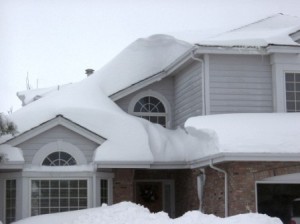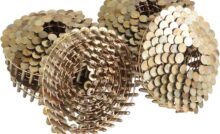Deep Snow Home Safety
With all the deep snow that’s piling up in the mid-west this winter I thought it was prudent to share this post about deep snow home safety.
Deep Snow Dangers


Each year heavy snow fall is responsible for severe damage to homes. Deep snow can cause structural damage and water damage. In addition, deep snow can cause carbon monoxide poisoning and serious fall injuries.
Structural Damage
Heavy deep snow can overload a roof structure and cause damage from cracked roof rafters to total roof collapse. Most new home construction meeting current building codes will handle deep snow loads with ease. However, older homes can sometimes fall victim to heavy deep snow loads. Even if you own a new home we recommend you remove some of the snow using a snow roof rake. Snow roof rakes allow you to safely remove snow from your roof without climbing up ladders and risking a high fall.
We recommend you try and use the snow roof rake to pull off approximately 2 to 4 feet of snow from the eves. Obviously if you have an older home with poor roof rafters (undersized, splits, checks, sagging, and obvious signs of distress) then you’ll want to remove as much snow as possible. It’s also a great idea to remove some snow from the eves on newer homes. This is important because it exposes the roofing material to the sun so melting can occur. This is also a great way to prevent ice dams from forming.
Utility Vent Clearances
Another major problem with deep snow is blocked furnace and hot water tank exhaust pipes. Today it’s very common for furnaces and water heaters to be “power vented” out the side of the house versus using a chimney. This can be very dangerous if the snow gets deep enough to block the exhaust pipe and cause carbon monoxide to back up into the home. Each year people lose their lives to carbon monoxide poisoning that’s caused by snow covering the exhaust pipes. So take the time to regularly check your exhaust pipe and be sure it’s not covered in snow.
Fall Injuries
Obviously snowy weather brings the risk of slipping and falling hazards. It’s really important to keep your walkways and driveways clear of snow and ice. We recommend using a mixture of calcium chloride and sand on your walkways after each storm. The mixture proves to be very effective in melting snow and ice and providing good traction to walk and drive on.
It’s also very important to use extreme caution when working on the roof when snow is present. If you must climb up onto a snow covered roof then take the time to set up a fall arrest rope. Use a heavy climbing rope tied to a tree or other secure object. Throw the rope over the ridge and use it to steady yourself. It only take a few minutes to set up and it’s a real help on slippery roofs.
Snow Blower Safety
Snow blowers are also responsible for seriously hurting many home owners each year. Snow blowers are a great way to remove deep snow quickly and safely. However, it’s really important to use snow blowers carefully and responsibly. It’s extremely important to shut off a snow blower completely before trying to remove plugged snow. NEVER try to clean out plugged snow with your hands or a stick while the machine is running.
Recent Posts
Framing Stick Nailer vs Coil Nailer
Which is Better a Stick Nailer or Coil Nailer? Framers have many choices in nailers…
How Many Roofing Nails Per Square of Shingles
Estimating How Many Nails for a New Roof When it comes to estimating materials for…
Composite / PVC Decking – Layout Tips & Advice
Composite / PVC Decking Layout Tips and Advice Composite and PVC decking have really changed…
Benefits of an ERV System (Energy Recovery Ventilator)
Benefits of ERV Systems (Energy Recovery Ventilator) If you're building a new home or doing…
Vermiculite Attic Insulation Abatement
Vermiculite Attic Insulation If your home was built before 1990 there is a chance it…
Nuisance Tripping of AFCI (Arc Fault) Circuit Breakers
Arc Fault (AFCI) Circuit Breakers Tripping Often An arc-fault circuit interrupter (AFCI) or arc-fault detection…

View Comments
Thanks for these tips, I appreciate your concern for everyone! You are really a great soul. Marry Christmas to you and your family!
Todd,
Great post!
I have a low furnace vent on my house. I built a folding "A" frame cover for it out of scrap plywood, 2 hinges and a chain.
The A frame is much taller than the vent and about 30" wide. It tucks against the house to cover the vent and allows snow to fall on either side but not build up and block the vent.
The hinges allow me to fold it and store it when done for the season.
@ Rob - Great idea! When we had our first home down in MA I remember a 33" snow storm that covered our low vent and I'll never forget it.
In Dayton,Ohio we encounter a lot of problems in the winter with ice-dams. The water freezes in the gutters causing any melting snow to back up under the shingles and run into the interior of the house through ceilings or low points some times causing significant interior damage.